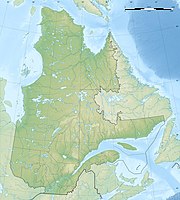Réserve écologique des Grands-Ormes
|
Réserve écologique des Grands-Ormes
|
||
| location | Charlevoix-Est , Québec, Canada | |
| surface | 9.2 km² | |
| WDPA ID | 66626 | |
| Geographical location | 47 ° 53 ' N , 70 ° 27' W | |
|
|
||
| Setup date | 1994 | |
| administration | MDDEP | |
The Réserve écologique des Grands-Ormes is a 920 hectare protected area established in 1995 in the south of the Canadian province of Québec , in the regional county municipality of Charlevoix-Est .
It is located 30 km north of Saint-Aimé-des-Lacs and is enclosed by the Parc national des Hautes-Gorges-de-la-Rivière-Malbaie , which in turn is part of the Charlevoix Biosphere Reserve .
The protected area of the Great Elms primarily represents the flora of the mountain ranges in the Charlevoix region, in which balsam fir , yellow and paper birch dominate. The area was placed under protection because of the northernmost occurrence of sugar maple and elm forests , but also of black ash . Large American elm populations gave the reserve its name, and they were the cause of its protection. Some of them are over 400 years old.
The area lies between 200 and 1000 m above sea level and includes the southern flank and part of the summit region of Mont des Érables ( 1030 m ). On the southern slope, a river, the Rivière Malbaie , and ice age glaciers created significant depressions. The aforementioned tree species are mainly found on the southern slope of the mountain. This southern exposure, which causes a milder microclimate, explains why these tree species occur so far north. In contrast, there is a typical tundra flora around the summit. There are cripple forms (called "crooked wood" in Québec). Twelve species of lichens and seven flowering plants were found in 1997, including Minuartia groenlandica , Salix uva-ursi and Vaccinium uliginosum subsp. gaultherioides . These arctic species make up 30% of the plants studied. Also noteworthy is Deparia achrostichoides or athyrium fausse-thélyptéride, a representative of the 180 or so species of lady fern .
Web links
- Réserve écologique des Grands-Ormes , government website

